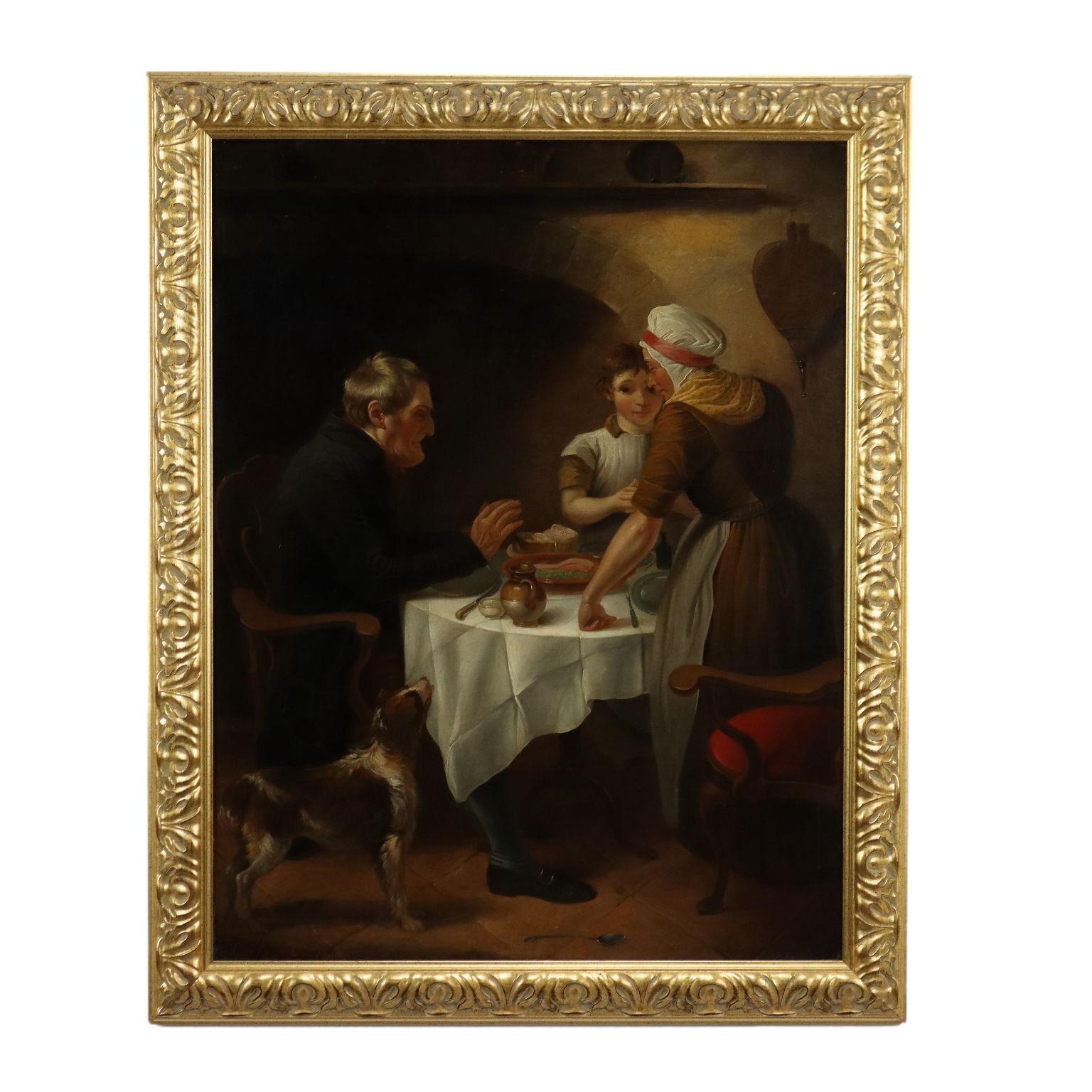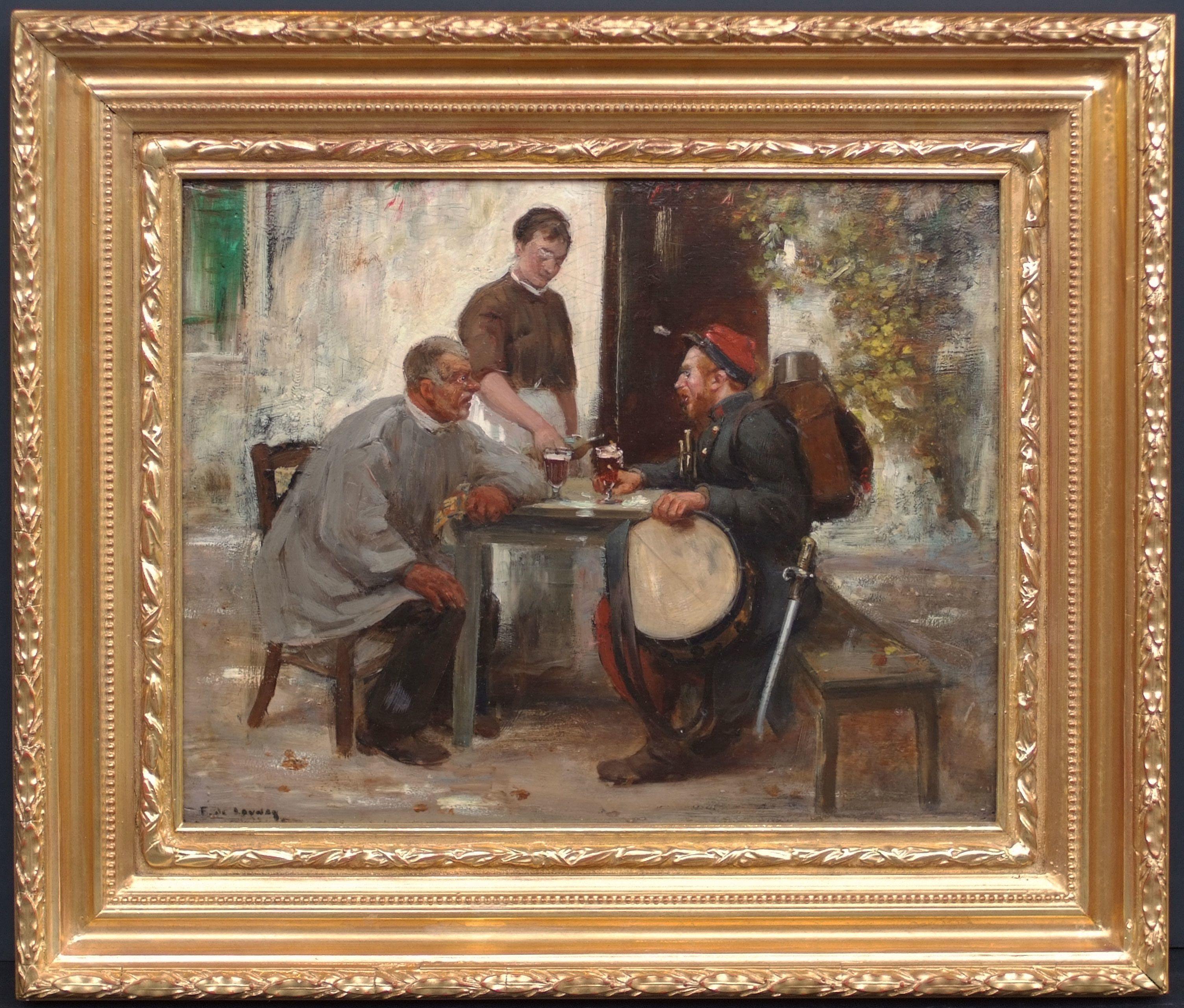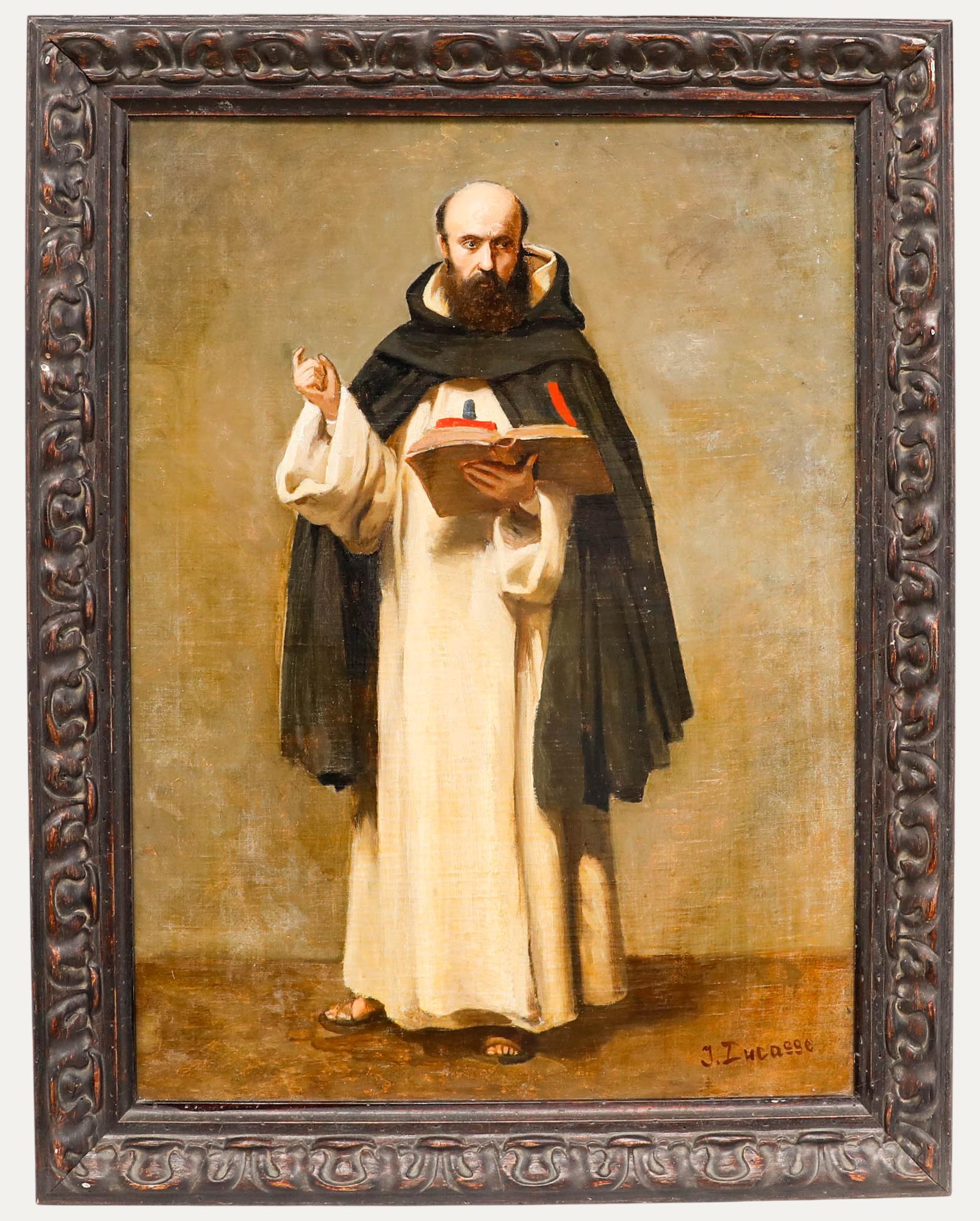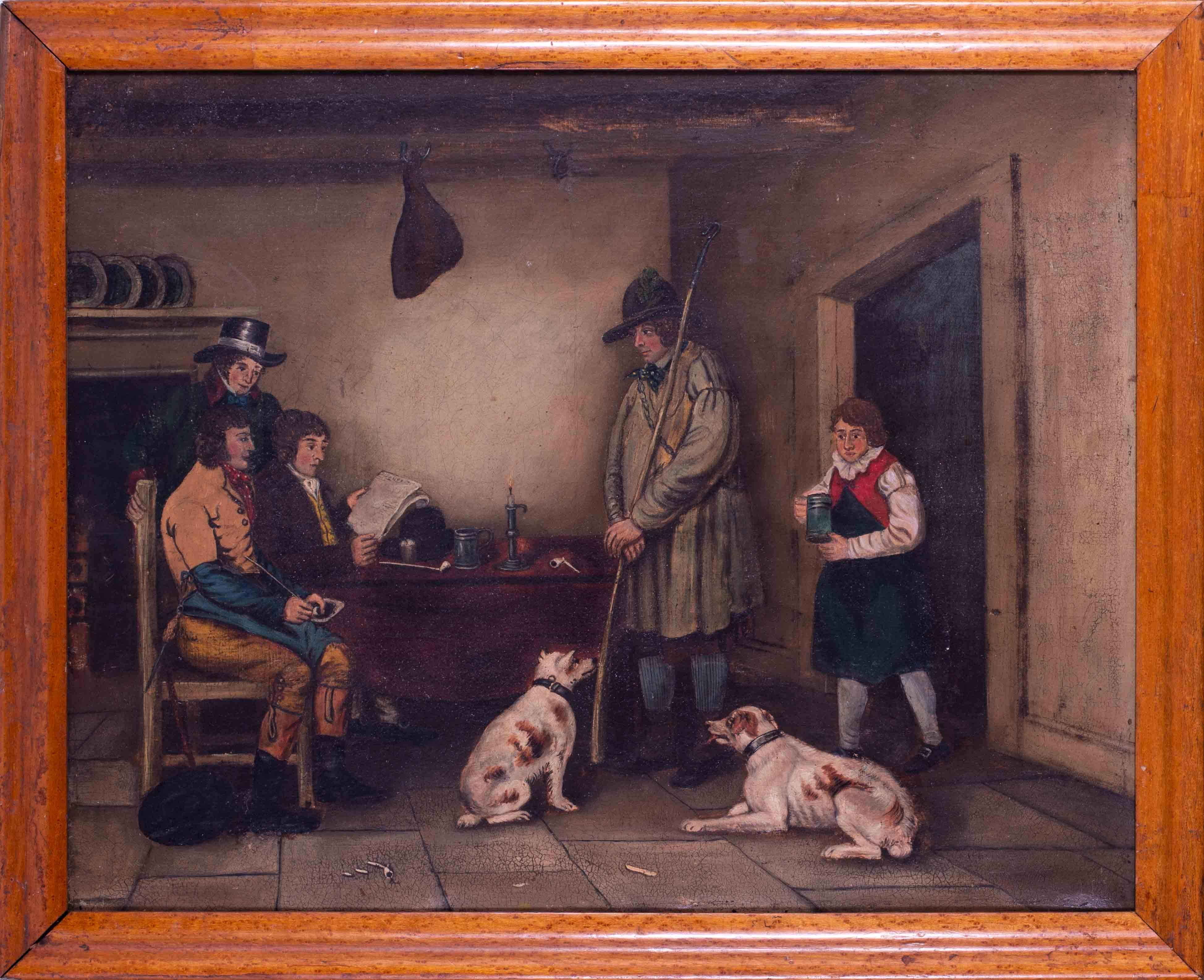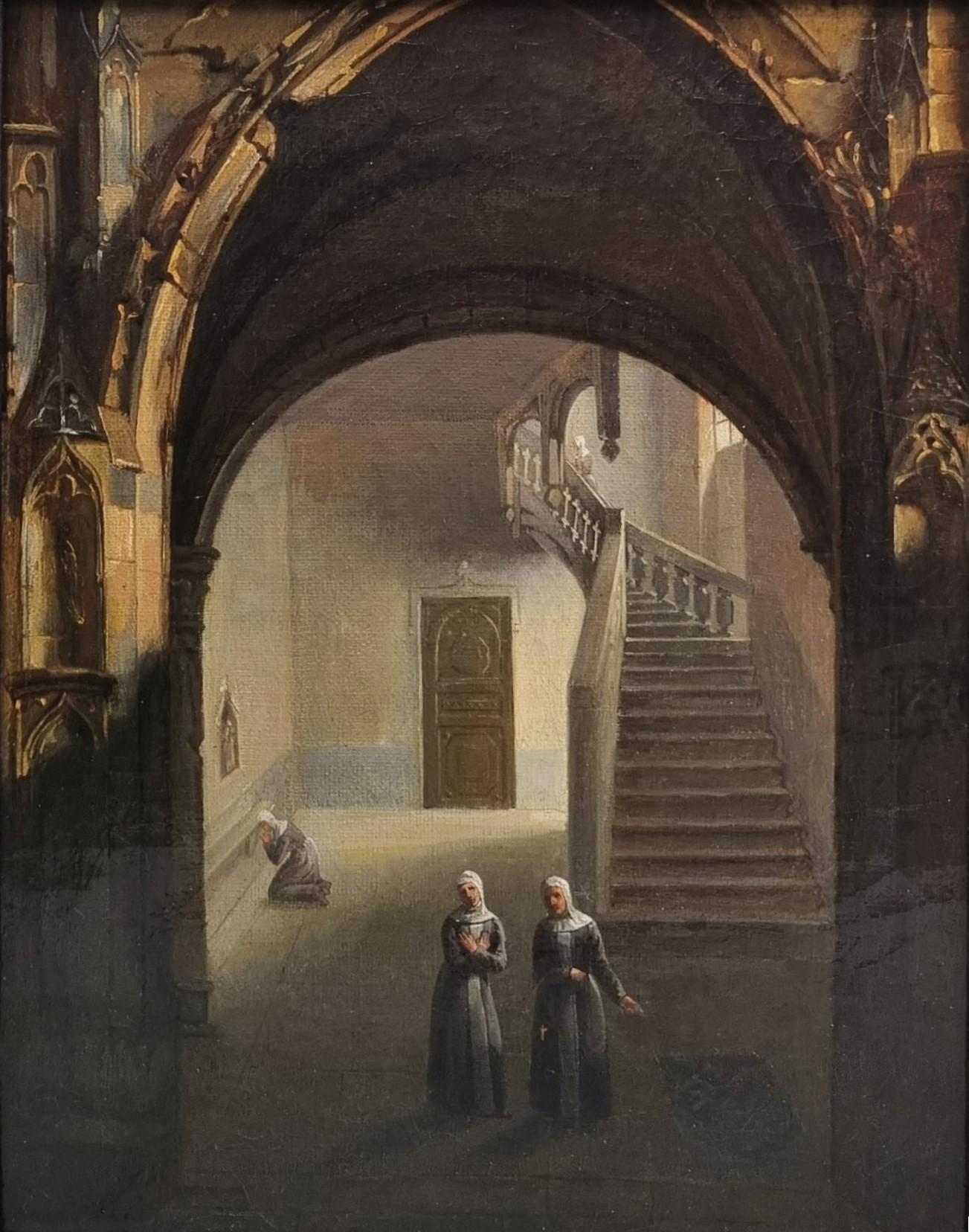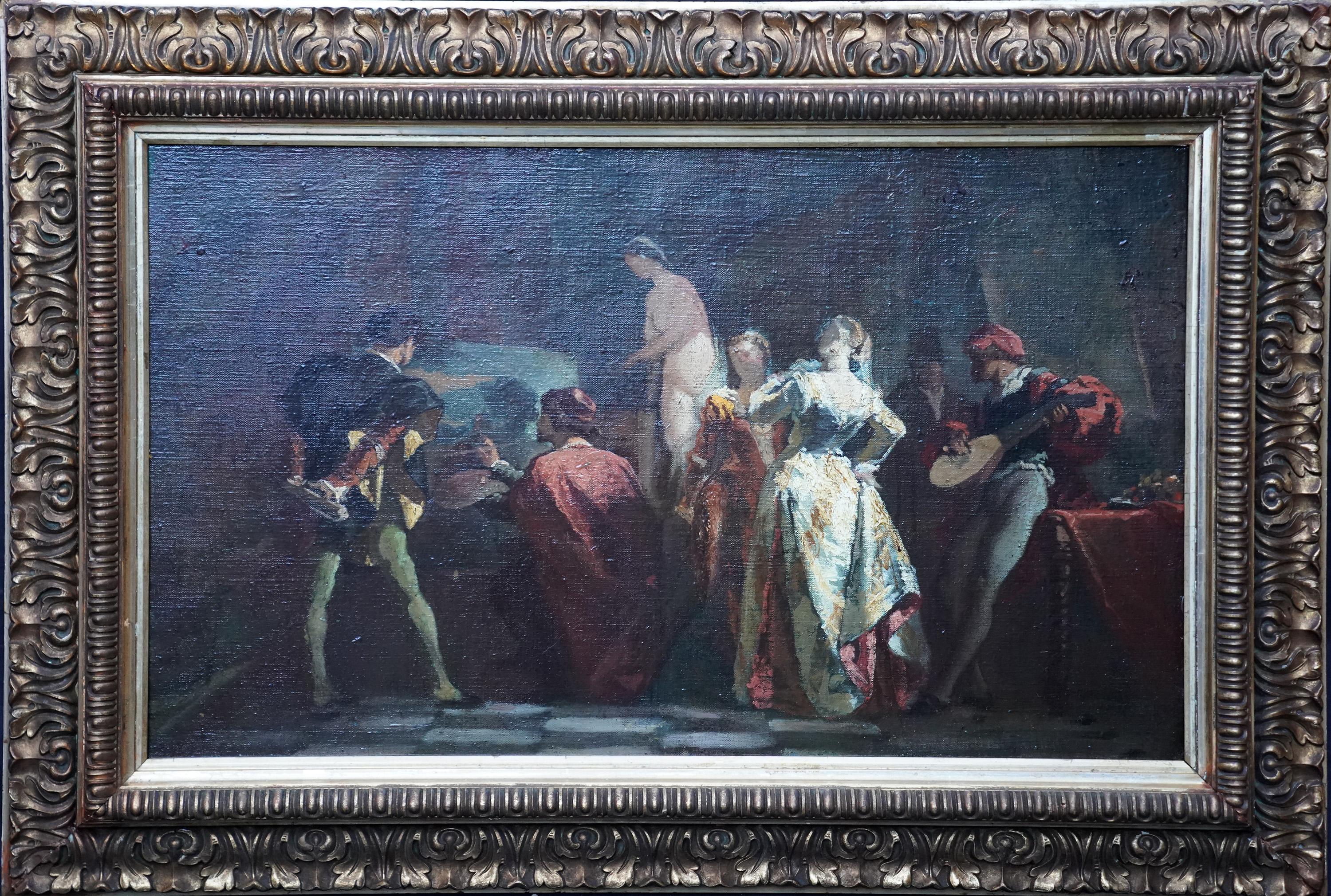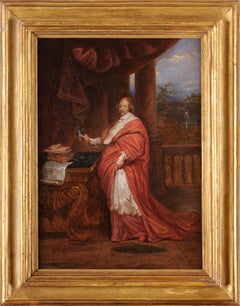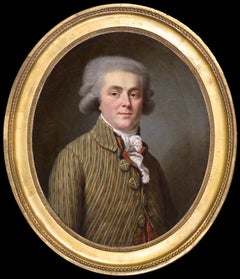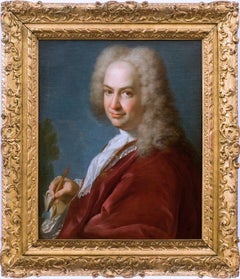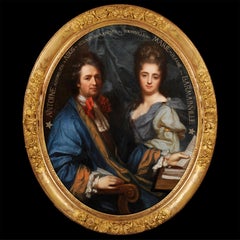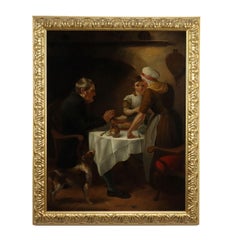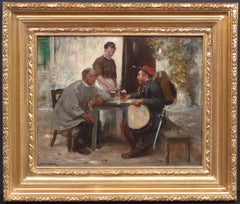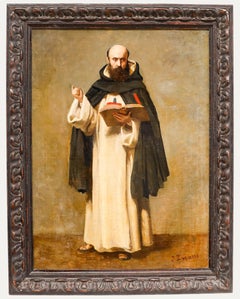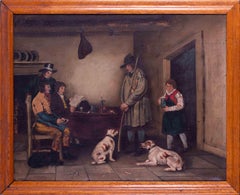Items Similar to A priest dinning in good company
Want more images or videos?
Request additional images or videos from the seller
1 of 8
Pierre Duval-LecamusA priest dinning in good companyCirca 1820
Circa 1820
$8,893.39
£6,608.51
€7,500
CA$12,308.98
A$13,707.03
CHF 7,156.75
MX$166,086.10
NOK 90,254.24
SEK 85,161.99
DKK 57,106.35
About the Item
Pierre DUVAL LECAMUS
(Lisieux 1790 - Saint-Cloud 1854)
Dinner in good company
Oil on canvas
H. 32.5 cm; W. 24.5 cm
Around 1820
Related works : - Painting from the 1822 Salon and kept at the National Museum of Education in Rouen, titled "L'Espièglerie"
A pupil of Claude Gautherot and Jacques-Louis David from 1808, Duval Lecamus was one of the main representatives of the genre scene under the Restoration and the July Monarchy, exhibiting successfully without interruption at the Salons from 1817 to 1853, not only in Paris but also many in the Provinces. His meticulous and polished style, inspired by the Nordic artists of the 17th century, perfectly corresponds to the tastes of the Duchess of Berry and the Duke of Orléans (future Louis-Philippe), and places him in the same sphere as artists such as: Boilly, Drolling, Grenier de Saint-Martin, Mallet, Roehn, Haudebourg-Lescot or Pingret. A relatively common practice among artists, he had attached to his name (Duval), and this from 1817, that of his wife (married in 1813), who belonged to a much higher class than his, in order to open doors in terms of clientele, but also to avoid confusion with another painter, Eustache-François Duval (1760-1836). Founder of the Lisieux Museum and for a time mayor of Saint-Cloud where he spent the end of his life, he had a son, Jules-Alexandre (1814-1878), who also had a great career as a painter. His works can be found in many French museums but also at the Hermitage in Saint Petersburg, or at the Clark Art Institute (USA). Pierre Duval Lecamus had two specialties: – Full-length portraits of elegant models, against a landscape background, small in size and brilliantly and refined in execution. – Genre scenes, interior or of peasant and popular inspiration (peasants, hunters, sailors, etc.), just as precise in their style.
Our painting belongs to this last category, and in particular to the theme of humorous interior scenes, which Duval Lecamus treated on many occasions at the beginning of his career. Our painting is part portrait, part genre scene and part social image. The priest in his apartments has received a lady for dinner, so the bag is still hanging on the straw chair. The remains of the meal for two people give us a glimpse of crayfish and a pâté en croûte accompanied by flutes certainly containing nothing better than a Champagne wine whose bottle is in the bucket. The woman seems to have left the table for a moment and the priest, standing up, extends his hand towards the empty chair. Does he wish to inspect the contents of the bag? In the background, a faience holy water font hanging near the front door is found in several other compositions by the painter with a priest as their central subject. On the right, a box bed seems unmade, the result of frolics near the dinner? A juicy element that joins the series of the painter's works, the children looking through the transom, the scene taking place in the private apartments of this father who seems to be in charge of a school. A fine example! A usual social criticism from this artist who makes the life of the population and its sins, choice morsels.
- Creator:Pierre Duval-Lecamus (1790 - 1854, French)
- Creation Year:Circa 1820
- Dimensions:Height: 12.8 in (32.5 cm)Width: 9.65 in (24.5 cm)
- Medium:
- Movement & Style:
- Period:
- Condition:
- Gallery Location:BELEYMAS, FR
- Reference Number:1stDibs: LU1857215760172
About the Seller
3.0
Vetted Professional Seller
Every seller passes strict standards for authenticity and reliability
Established in 2017
1stDibs seller since 2022
5 sales on 1stDibs
- ShippingRetrieving quote...Shipping from: BELEYMAS, France
- Return Policy
Authenticity Guarantee
In the unlikely event there’s an issue with an item’s authenticity, contact us within 1 year for a full refund. DetailsMoney-Back Guarantee
If your item is not as described, is damaged in transit, or does not arrive, contact us within 7 days for a full refund. Details24-Hour Cancellation
You have a 24-hour grace period in which to reconsider your purchase, with no questions asked.Vetted Professional Sellers
Our world-class sellers must adhere to strict standards for service and quality, maintaining the integrity of our listings.Price-Match Guarantee
If you find that a seller listed the same item for a lower price elsewhere, we’ll match it.Trusted Global Delivery
Our best-in-class carrier network provides specialized shipping options worldwide, including custom delivery.More From This Seller
View AllCardinal Mazarin portrait
Located in BELEYMAS, FR
French School circa 1645
Portrait of Cardinal Mazarin - Sketch
Oil on canvas
H. 41.5 cm; W. 27 cm
Provenance: Collection of the Reverend Georges Downing Bowles (1789-1863)
Would ...
Category
1640s French School Portrait Paintings
Materials
Canvas, Oil
Portrait of a man during French Revolution
Located in BELEYMAS, FR
Antoine VESTIER, attributed to
(Avallon, 1740 - Paris, 1824)
Portrait of a man under the Revolution
Oil on canvas
H. 46 cm; L. 37 cm
Circa 1793-95
This beautiful unsigned portrait i...
Category
1790s French School Figurative Paintings
Materials
Canvas, Oil
Presumed artist self-portrait
Located in BELEYMAS, FR
Louis-Gabriel BLANCHET
(Versailles, 1701 – Rome, 1772)
Presumed self-portrait of the artist
Oil on canvas
H. 73 cm; W. 60 cm
Circa 1730
Originally presented in a Restoration period frame with a "Mignard" cartouche, this beautiful painting initially appeared to us as a work from northern Italy. However, it exuded a rather French form of refinement, suggesting that its artist may have assimilated a dual influence from both sides of the Alps.
We thank our colleague and friend Philippe Mendès for spontaneously and judiciously "bringing out" the name of Louis-Gabriel Blanchet, a Romanized French portraitist, whose spirit and stylistic characteristics we clearly recognize here.
Blanchet's "French" years, before his final departure for Rome in 1728, following his winning of the second Grand Prix for painting after Subleyras in 1727, are extremely poorly documented. His father, Gabriel, was valet to Blouin, himself Louis XIV's first valet at the time. According to Thierry Lefrançois, Blanchet was one of the few students of Nicolas Bertin (1667-1736), whose studio he is said to have joined in the early 1720s. At a baptism on March 24, 1724, where he was godfather, he is mentioned as a painter in the picture store of the Duke of Antin, the director of buildings between 1708 and 1736. At this time, he was probably already married to Jeanne Quément, with whom he had a daughter also named Jeanne, who would marry Nicolas Aviet, the son of a valet in the queen's wardrobe, in Versailles in 1738.
When Blanchet arrived in Rome in October 1728, he was accompanied by Subleyras, Trémolières, and Slodtz. He enjoyed the goodwill of Vleughels, the director of the Académie de France, which had been based at the Palazzo Mancini since 1725, even though the latter was not always kind to our resident. From 1732, he was under the protection of the Duke of Saint-Aignan when he took up his post as ambassador to Rome. Along with Slodtz and Subleyras, they formed a trio of friends, joined by Joseph Vernet shortly after his arrival in Rome in 1734. Slodtz and Blanchet, on the occasion of Subleyras's marriage in 1739, were there to attest that their friend was not bound by any marital commitment, and Blanchet was a witness at Vernet's wedding in 1745.
It is most likely from these early years in Rome that our portrait of the artist dates, the expression and turn of his face irresistibly reminiscent of a self-portrait. The still relatively youthful features may correspond to Blanchet's thirty-something years, and the fluffy wig was still fashionable at this time.
The painting fits well with the depiction of a young painter wanting to display both the beginnings of success and a certain simplicity or restraint. A slight smile expresses a form of assurance in this man with a gentle, sincere gaze and a face radiating a keen sense of wit. We find here the air of intimacy present in almost all of Blanchet's portraits, even those from the 1750s and 1760s, as well as an almost complicity with the viewer. The spirit of the painting is quite close to that of the presumed portrait of Bouchardon (painted around 1730) and the portrait of Pannini, painted in 1736, but it possesses a more natural quality, notably thanks to the absence of decorum. Our work exhibits the characteristics of Blanchet's paintings: elegance, luminosity (especially in the whites), vibrant and refined colors (here, the harmony of the garnet of the garment and the slate blue of the background, whose uniformity is tempered by a very sketched landscape and a grove of greenery), light complexions, rather rosy cheekbones, often full lips, and rather tight framing.
According to the Academy's rules, Blanchet's stay should have ended in the spring of 1732, but, for reasons unknown, he remained in the Eternal City until his death, as did his friend Subleyras, with whom he shared accommodation until the late 1730s. The latter regularly called upon him to collaborate on his paintings, such as The Meal at Simon's. Through Saint-Aignan's intervention, Blanchet was employed in the late 1730s by the Stuart princely family, then exiled in Italy. He notably produced copies (now lost) after Liotard of the portraits of Charles Edward and Henry Benedict, the sons of James III Stuart. The latter also commissioned three other portraits (now in the National Portrait Gallery in London), whose more formal character contrasts with the intimate spirit of Blanchet's portraits. Blanchet frequented English painters, such as the landscape painter Richard Wilson, and studied with the Scottish portraitist Katherine Read...
Category
1730s French School Portrait Paintings
Materials
Oil, Canvas
Portrait of a couple
Located in BELEYMAS, FR
Jean-Baptiste SANTERRE
(Magny en Véxins 1651 - Paris 1717)
Portrait of a couple
Oil on original oval canvas
H. 115 cm; L. 90 cm (140 x 115 cm with frame)
Around 1695
Jean-Baptiste S...
Category
1690s French School Portrait Paintings
Materials
Canvas, Oil
Still-life of various art objects
Located in BELEYMAS, FR
François CARLIER-RUBRECQ
(active around 1820-1830)
Study of various works of art
Oil on canvas
H. 50 cm; L. 58.5 cm
Signed and dated upper left, countersigned on the stretcher 1825
...
Category
1820s French School Still-life Paintings
Materials
Oil, Canvas
Italian men portrait
By Giovanni Maria delle Piane dit Mulinaretto (Genoa 1670 - Monticelli d´Ongina 1745)
Located in BELEYMAS, FR
Giovanni Maria DELLE PIANE, known as IL MULINARETTO
(Genoa, 1660 – Monticelli d'Ongina, 1745)
Portrait of a man
Oil on oval canvas
H. 108 cm; L. 83 cm
Provenance: Nino Ferrari Colle...
Category
1740s Italian School Portrait Paintings
Materials
Canvas, Oil
You May Also Like
The Family Lunch 1802 Painting by Charles Christophe Coventry
Located in Milan, IT
Oil on Canvas. Signed and dated to the lower left.
A genre scene in popular taste, it portrays a middle-class family about to have lunch: the father, already seated at the table, is ...
Category
19th Century Other Art Style Figurative Paintings
Materials
Oil
Break at the Inn for the Rural Policeman 19th Century
Located in Saint-Ouen, FR
DE LAUNEY Fernand (19th Century)
Break at the Inn for the Rural Policeman
Oil on Wood Panel signed Low Left
Old frame gilded with Leaves
Dim wood : 33 X 41 cm
Dim frame : 48 X 56 cm...
Category
1880s Academic Portrait Paintings
Materials
Oil
J. Ducasse - French School Late 19th Century Oil, The Preaching Monk
Located in Corsham, GB
This striking portrait depicts a monk standing in a contemplative pose while holding an open book. The composition is centred on the solitary figure, whose white robes and dark cloak...
Category
Late 19th Century Portrait Paintings
Materials
Oil
Early 19th Century, English provincial school, 'Travellers at the inn
Located in Petworth, West Sussex
English Provincial School, early 19th Century
Travellers at an inn
Oil on canvas
17 x 21 in. (43.2 x 53.3 cm.)
Category
19th Century English School Figurative Paintings
Materials
Canvas, Oil
French painting Troubadour Interior Convent Nuns mid 19th
By Francois-Marius Granet
Located in PARIS, FR
François-Marius GRANET (Circle of)
Aix-en-Provence, 1775 – Aix-en-Provence, 1849
Convent interior with nuns
Oil on canvas
35 x 27.5 cm (39.5 x 31 cm with frame)
Beautiful black and g...
Category
Mid-19th Century Romantic Interior Paintings
Materials
Oil
Artist in his Studio - French 19th century art figurative interior oil painting
By Adolphe Monticelli
Located in Hagley, England
This lovely French 19th century figurative Impressionist oil painting is by Adolphe Monticelli. Painted circa 1870 the painting depicts a group of seven figures amusing themselves in...
Category
19th Century Realist Portrait Paintings
Materials
Oil
More Ways To Browse
French Antique Company
Oil Painting 1820
Antique Artist Paint Box
Woman Wine
French Priest
Louis Claude Artist
Antique Bed Chair
Painting Of Wine Bottle
Oil Priests
Oil Painting Priest
Portrait Of Sailor
Hunters Table
Jacques Louis David
1790 Oil Painting
Antique Bed Box
Antique Full Size Beds
Antique Holy Water
Antique Wine Box
